Everything from product design to buying decisions creates data.
In such a data-rich environment, the way organizations function and compete is defined by how well they use it.
However, legacy systems weren't designed for modern, real-time demands on data. Organizations today need infrastructure that adapts instantly and delivers insights at the speed of business.
This growing demand for quick and accurate information has driven the rise of cloud data platforms.
Cloud data platforms do offer this capability by removing the limits of traditional systems.
They bring all data together in one place, enabling teams to make quicker, more confident decisions.
We will now understand how cloud data platforms operate.
What are cloud data platforms?
A cloud data platform is a centralized architecture. The data is stored and analyzed without relying on physical servers. It gives teams a more flexible and reliable way to work with information, especially as data volumes grow.
Cloud platforms can easily handle structured and unstructured data. They can provide real-time insights and reduce maintenance costs. For most businesses, cloud data platforms eliminate the cumbersome, inefficient on-premise variants. They also allow teams to focus more on insights than infrastructure.
Now that you know what they are, let's talk about why they're valuable.
The Cloud Data Revolution
The shift toward cloud-first data operations has been rapid. As digital processes generate more information, traditional systems struggle to keep up. Cloud platforms solve this challenge by providing an environment that adapts to ongoing data demands without disruption.
It is not only a technology shift; it’s also a strategic one.
Businesses now use data in motion to understand customers and make decisions in real time. This ability has become a defining factor in today’s competitive landscape.
So, let us now look into the architecture behind cloud data platforms that translate into this capability.
Architecture: How Cloud Data Platforms Work
Every cloud data platform is based on a layered architecture that separates resources to allow independent scaling.
Most architectures have 4 functional layers, including:
1. Cloud Data Centers:
Providers like AWS, Azure, and Google Cloud operate distributed fulfillment centers. This allows for high availability, global access, and built-in redundancy.
2. Storage Layer:
Data is stored as elastic objects. It is a form of cloud storage designed to automatically expand or contract based on data volume, making it easier to stay efficient as data grows.
3. Compute Layer:
This layer hosts workloads in virtual clusters. Compute resources can be increased when heavy processing is required or decreased to manage cost.
4. Services Layer:
This layer provides governance and access management. It also optimizes queries. This ensures consistency and compliance in all data-related processes.
Its greatest advantage is simple: cost and performance can be managed independently.
Understanding the architecture reveals the know-how. The next step is to see what this means for businesses.
Business Impact: From Architecture to Advantage
Modern data platforms are a combination of automation and business intelligence. This creates practical advantages for businesses, as shown below:
|
Benefit |
Business Outcome |
|
Scalability |
Expands automatically as workloads grow |
|
Cost Control |
Pay only for the resources used |
|
Collaboration |
Shared data access improves teamwork |
|
Resilience |
Multi-region backups reduce downtime |
|
AI Readiness |
Data pipelines prepare assets for model training |
These features equip companies with enhanced operational resilience and faster time-to-insights.
The trend toward cloud-native environments is an obvious sign of changing business priorities. Organizations no longer view the cloud as just backend infrastructure. It has become a tool for competitive positioning, powered by speed and intelligence.
Governance and Security: Building Trust in the Cloud
With scaling comes the risk of misuse and violations, especially when data flows freely across cloud environments. Cloud technology provides access to large volumes of information without being bound by physical constraints. In a framework like this, integrity and ethical use must be maintained at every level.
It is imperative to define who can access what, and with what level of security. This makes governance essential to business operations..
Top cloud data platforms encrypt data both at rest and in transit. In addition, they implement zero-trust infrastructures and audit trails with extensive detail. Role-based access control ensures that sensitive data is only accessed by responsible users.
Compliance with laws such as GDPR and HIPAA is built into many solutions. Another key feature is data lineage. It allows teams to trace every data movement and verify its origin.
This combination of transparency and control creates trust in cloud-driven analytics.
Expert Insight: Industry Perspective
To explore the practical side of cloud platforms' evolution, we spoke with Fawad A. Qureshi, Snowflake’s Global Field CTO. He emphasized that cloud data platforms have moved far beyond storage. They function as activation layers that power enterprise intelligence.
He explained that companies want deeper clarity into how customers interact with their systems and how those behaviors shape outcomes.
Check out the full interview here.
Conclusion
The real value of cloud data platforms lies in unifying data and computing into a system that adapts as fast as business conditions change.
As companies shift toward AI-driven operations, cloud platforms provide the architecture powered by governance that is flexible enough to support real-time decision cycles.
Organizations using cloud platforms will gain faster insights and a foundation ready for the next wave of AI-native applications. These companies will also enjoy a competitive advantage in the years ahead.


